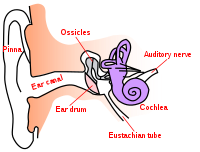
Photo from wikipedia
Abstract Objective: In order to help a surgeon make the best decision, a more objective method of measuring ossicular motion is required. Methods: A laser Doppler vibrometer was mounted on… Click to show full abstract
Abstract Objective: In order to help a surgeon make the best decision, a more objective method of measuring ossicular motion is required. Methods: A laser Doppler vibrometer was mounted on a surgical microscope. To measure ossicular chain vibrations, eight patients with cochlear implants were investigated. To assess the motions of the ossicular chain, velocities at five points were measured with tonal stimuli of 1 and 3 kHz, which yielded reproducible results. The sequential amplitude change at each point was calculated with phase shifting from the tonal stimulus. Motion of the ossicular chain was visualized from the averaged results using the graphics application. Results: The head of the malleus and the body of the incus showed synchronized movement as one unit. In contrast, the stapes (incudostapedial joint and posterior crus) moved synchronously in opposite phase to the malleus and incus. The amplitudes at 1 kHz were almost twice those at 3 kHz. Conclusions: Our results show that the malleus and incus unit and the stapes move with a phase difference.
Journal Title: Acta Oto-Laryngologica
Year Published: 2017
Link to full text (if available)
Share on Social Media: Sign Up to like & get
recommendations!